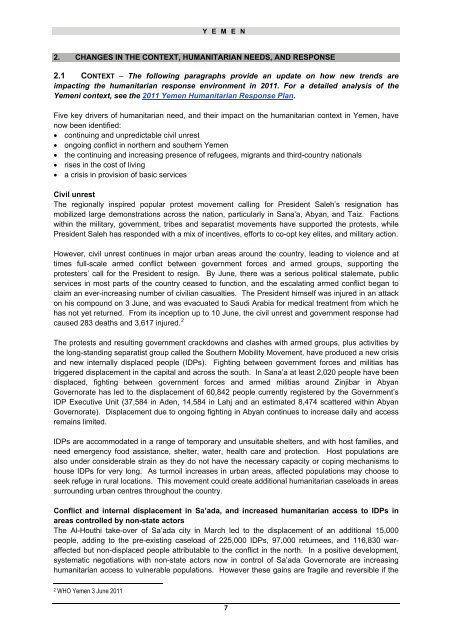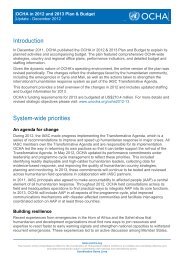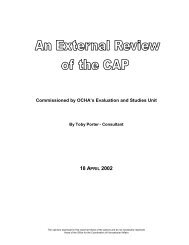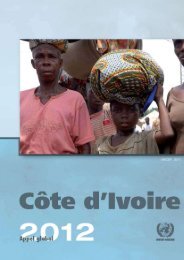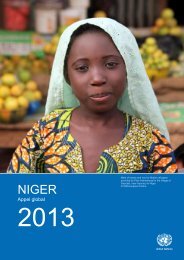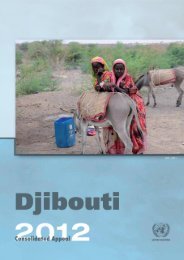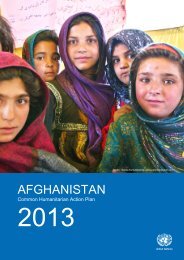Yemen 2011 Mid-Year Review - UN OCHA Webmail
Yemen 2011 Mid-Year Review - UN OCHA Webmail
Yemen 2011 Mid-Year Review - UN OCHA Webmail
- No tags were found...
Create successful ePaper yourself
Turn your PDF publications into a flip-book with our unique Google optimized e-Paper software.
Y E M E N2. CHANGES IN THE CONTEXT, HUMANITARIAN NEEDS, AND RESPONSE2.1 CONTEXT – The following paragraphs provide an update on how new trends areimpacting the humanitarian response environment in <strong>2011</strong>. For a detailed analysis of the<strong>Yemen</strong>i context, see the <strong>2011</strong> <strong>Yemen</strong> Humanitarian Response Plan.Five key drivers of humanitarian need, and their impact on the humanitarian context in <strong>Yemen</strong>, havenow been identified:• continuing and unpredictable civil unrest• ongoing conflict in northern and southern <strong>Yemen</strong>• the continuing and increasing presence of refugees, migrants and third-country nationals• rises in the cost of living• a crisis in provision of basic servicesCivil unrestThe regionally inspired popular protest movement calling for President Saleh’s resignation hasmobilized large demonstrations across the nation, particularly in Sana’a, Abyan, and Taiz. Factionswithin the military, government, tribes and separatist movements have supported the protests, whilePresident Saleh has responded with a mix of incentives, efforts to co-opt key elites, and military action.However, civil unrest continues in major urban areas around the country, leading to violence and attimes full-scale armed conflict between government forces and armed groups, supporting theprotesters’ call for the President to resign. By June, there was a serious political stalemate, publicservices in most parts of the country ceased to function, and the escalating armed conflict began toclaim an ever-increasing number of civilian casualties. The President himself was injured in an attackon his compound on 3 June, and was evacuated to Saudi Arabia for medical treatment from which hehas not yet returned. From its inception up to 10 June, the civil unrest and government response hadcaused 283 deaths and 3,617 injured. 2The protests and resulting government crackdowns and clashes with armed groups, plus activities bythe long-standing separatist group called the Southern Mobility Movement, have produced a new crisisand new internally displaced people (IDPs). Fighting between government forces and militias hastriggered displacement in the capital and across the south. In Sana’a at least 2,020 people have beendisplaced, fighting between government forces and armed militias around Zinjibar in AbyanGovernorate has led to the displacement of 60,842 people currently registered by the Government’sIDP Executive Unit (37,584 in Aden, 14,584 in Lahj and an estimated 8,474 scattered within AbyanGovernorate). Displacement due to ongoing fighting in Abyan continues to increase daily and accessremains limited.IDPs are accommodated in a range of temporary and unsuitable shelters, and with host families, andneed emergency food assistance, shelter, water, health care and protection. Host populations arealso under considerable strain as they do not have the necessary capacity or coping mechanisms tohouse IDPs for very long. As turmoil increases in urban areas, affected populations may choose toseek refuge in rural locations. This movement could create additional humanitarian caseloads in areassurrounding urban centres throughout the country.Conflict and internal displacement in Sa’ada, and increased humanitarian access to IDPs inareas controlled by non-state actorsThe Al-Houthi take-over of Sa’ada city in March led to the displacement of an additional 15,000people, adding to the pre-existing caseload of 225,000 IDPs, 97,000 returnees, and 116,830 waraffectedbut non-displaced people attributable to the conflict in the north. In a positive development,systematic negotiations with non-state actors now in control of Sa’ada Governorate are increasinghumanitarian access to vulnerable populations. However these gains are fragile and reversible if the2WHO <strong>Yemen</strong> 3 June <strong>2011</strong>7


